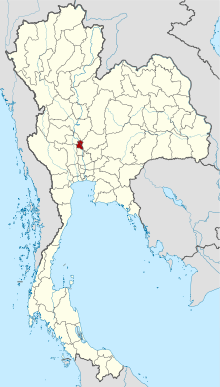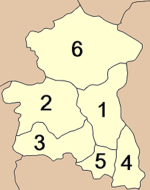Sing Buri Province
| Sing Buri สิงห์บุรี | ||
|---|---|---|
| Province | ||
| ||
| Nickname(s): Land of heroes and courageous people, the reclining Buddha image, famous fish of Mae La, and the trading area of the central region | ||
 Map of Thailand highlighting Sing Buri Province | ||
| Country |
| |
| Capital | Sing Buri town | |
| Government | ||
| • Governor | Phasin Komonwit (since October 2016) | |
| Area | ||
| • Total | 822.5 km2 (317.6 sq mi) | |
| Area rank | Ranked 73rd | |
| Population (2014) | ||
| • Total | 212,158 | |
| • Rank | Ranked 72nd | |
| • Density | 260/km2 (670/sq mi) | |
| • Density rank | Ranked 11th | |
| Time zone | ICT (UTC+7) | |
| ISO 3166 code | TH-17 | |
Sing Buri (Thai: สิงห์บุรี, pronounced [sǐŋ būrīː]) is one of the central provinces (changwat) of Thailand.[1] Neighboring provinces are (from north clockwise) Nakhon Sawan, Lop Buri, Ang Thong, Suphan Buri, and Chai Nat.
Etymology
The word sing originates from Sanskrit singh meaning "lion" and buri, from Sanskrit puri meaning buri mueang "fortified city" or "town". Hence the literal translation is "lion city", sharing the same root as Singapore.
Geography
Sing Buri is on the flat river plain of the Chao Phraya River valley.
History
The area of Sing Buri held an important position in early Thai history from the Dvaravati period down to the Ayutthaya period. Formerly the province was separated into three small provinces, In Buri, Prom Buri, and Sing Buri, which were unified by King Chulalongkorn (Rama V) in 1895.[1]
Symbols
The provincial seal shows the fort of Khai Bangrachan, a historical monument. When the Burmese attacked Ayutthaya in 1765, 11 villagers from Bangrachan fought the army when it stopped north of Ayutthaya. They managed to delay them for five months before they were finally defeated, soon thereafter Ayutthaya fell as well. Annually on 4 February a ceremony is held in remembrance of these local heroes. This story was also made into a movie in Thailand.
The provincial tree is the Red Sandalwood Tree (Adenanthera pavonina).
Administrative divisions

The province is subdivided into six districts (amphoe).[1] The districts are further subdivided into 43 communes (tambon) and 363 villages (muban).
References
- 1 2 3 "Sing Buri". Tourism Authority of Thailand (TAT). Retrieved 6 May 2015.
- ↑ http://www.ratchakitcha.soc.go.th/DATA/PDF/2547/E/129/001.PDF
External links
 Sing Buri travel guide from Wikivoyage
Sing Buri travel guide from Wikivoyage
| Wikimedia Commons has media related to Sing Buri. |
- Website of Province (Thai)
- Singburi provincial map, coat of arms and postal stamp Archived October 6, 2010, at the Wayback Machine.
 |
Chainat Province | Nakhon Sawan Province |  | |
| |
Lopburi Province | |||
| ||||
| | ||||
| Suphanburi Province | Ang Thong Province |
Coordinates: 14°53′35″N 100°24′42″E / 14.89306°N 100.41167°E

